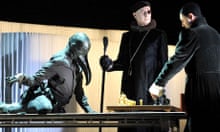Flop off the Pendolino, dodge the weekend hen parties patrolling Piccadilly station – and you emerge into a giant marketing jamboree. That's not unusual in a city centre, except that what visitors to Manchester are being sold is Manchester itself. Bus stops are decorated with an M wrought out of tram tracks. The boards covering up council repairs near the Arndale shopping centre are plastered with pictures of the Smiths, Lowry, Coronation Street; a regionalist cultural iconography that's almost as interesting for its omissions (neither Anthony Burgess nor Harrison Birtwistle feature – and not a single black person). Even the property developers converting derelict warehouses into offices for the Mac-toting classes put up signs that read "inspirational", "creativity" and "transformation".
None of this municipal hype is accidental or bolted on; it's at the core of local government attempts to revive an area that 30 years ago looked out for the count. The international festival that's taking over the city this month is canny PR: a not-so-subtle argument that Manchester is (as the programme puts it) "the cultural heart of England".
Seated on AstroTurf carefully placed to lend Albert Square some festive élan, council leader Richard Leese tells me about officials' efforts a decade ago to define a "Brand Manchester" they could go out and sell.
It came down to three local attributes, he says: "Openness. Inclusivity. And a certain amount of swagger." Then he uses a phrase coined by the local designer of some of the most famous record sleeves ever, Peter Saville: "Manchester is the 'original modern'." It sounds like the usual quasi-mystical guff dreamed up by costly consultants, but then I notice those two words popping up again and again, even in adverts for neighbourhood law firms.
Manchester is the city that tried to turn itself around by turning itself into a brand. In the 1980s, Mancunians were faced with the same problem as their counterparts in Leeds, Liverpool, Birmingham and elsewhere: a collapse in manufacturing, a surge in unemployment and social deprivation – for the world's first industrial cities, what looked like a giant historical dead end. Strolling around the city now, it's clear what the local answer has been: smarten up the centre, specialise in service sectors – everything from accountancy to restaurants, drive money into housing, and have a good story to tell about where you've been and where you're going.
The result has been an undeniable improvement. Here is the most astonishing fact about Manchester's regeneration: where residents were once desperate to leave the city, now, for the first time in 50 years, people are flocking back. Jobs? While 186,000 manufacturing jobs were shed in Greater Manchester between 1981 and 2006, there was a net gain of 187,000 over the same period, most pronouncedly in finance, media as well as public-sector health and education. Accompanying all this is a distinct improvement in atmosphere. Critics might complain about the commercial takeover of the centre, but anyone who would prefer Piccadilly Gardens in its former guise as a heroin-needle exchange rather than a place with water fountains and young children chasing pigeons is putting their politics before their personal safety.
What's wrong with this picture? Well, as Adam Leaver of Manchester University's Centre for Research on Socio-Cultural Change puts it to me in a Northern Quarter cafe run by a DJ (and you don't get much more New Manchester than that): "The city has a great brand – but any brand is full of tensions and contradictions." Here, that means the tide of regeneration stops well short of the north and the east of the city, and hasn't touched those not qualified to take up the smart white-collar jobs.
In Miles Platting in the east of the city, I ran into Terry wheeling along his toddler Jasmine. What did he make of the city's revival? He turned and gestured back down the main road: "All the new jobs and offices stop halfway down there. We haven't seen any of the money up here." The figures bear him out: in 2009 a study by the Centre for Cities reviewed 56 English cities, and found Manchester the most unequal in the gap between its richest and poorest areas. Boosters point to the Sportcity in the east of the city – but no national cycling centre is ever going to match the now extinct heavy engineering firms of Trafford Park for job creation.
The other big worry must be David Cameron's spending cuts. While Manchester has managed to turn itself into the de facto regional headquarters for big business, its main employers remain the health trusts, local government and the string of university buildings that line Oxford Road. All of these areas are seeing their finances cut, some sharply, over the next four years – the result is likely to be massive job losses.
Planners and bureaucrats across Europe now visit Manchester in search of an answer to one of the biggest questions of modern times: how do you make work that apparent oxymoron, the post-industrial city? Yet Manchester shows that while a smart local government can do a lot to improve the look and feel of a city, it still hasn't got a good answer to what replaces the old industry. There, the obstacle isn't local – it lies down south in Whitehall and Westminster.







